De Zeventiende Eeuw. Jaargang 21
(2005)– [tijdschrift] Zeventiende Eeuw, De–
[pagina 128]
| |
Otto Vaenius' Emblemata Horatiana and the azulejos in the
monastery of São Francisco in Salvador de BahíaGa naar voetnoot*
| |
[pagina 129]
| |
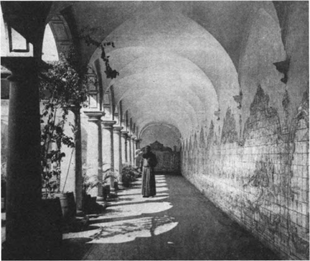
Fig 1 The cloister of the monastery of São Francisco, Salvador de
Bahía.
The imagery on the ground-floor tile panels derives from an early seventeenth-century publication: an emblem book by Otto Vaenius (Leyden 1556 - Brussels 1629), a selection of excerpts from Horace augmented with emblematic illustrations. Vaenius' book was first published in 1607 with the title Quinti Horati Flacci Emblemata and subsequently knew many editions.Ga naar voetnoot5 This article will examine the peculiarities of this rare example of a Luso-Dutch artistic hybrid as well as the migration and transformation of pictorial forms and concepts from emblematic literature from the Netherlands to religious culture in a Portuguese colony from book illustration to large-scale architectonic decoration. We are unfamiliar with the origins and the year from which the panels date, nor do we know the name of the artist responsible for the tiles.Ga naar voetnoot6 It is probable that the tiles were produced in a studio in Portugal; they are often mentioned in connection to the name of Bartolomeu Antunes da Jesus since his signature can be found on a tile panel in the church nearby. The execution of this church panel, however, differs considerably | |
[pagina 130]
| |
from the tiles in the cloister, and the attribution therefore cannot be sustained.Ga naar voetnoot7 The team responsible for the tiles may have consisted of Portuguese artists working in a Dutch studio, presumably in Delft.Ga naar voetnoot8 Even the contribution of Dutch artists to the preliminary design or to the painting and glazing process cannot be ruled out altogether. It is practically impossible to establish the origins of decorative tiles or to trace their route to the New World, since tiles were used as ballast in ships, which is why they are so profusely present in Brazilian harbour towns along the coastal regions, from Salvador in Bahía to São Luiz de Maranhão in the north. The artistic merits of the decoration project are difficult to judge from reproductions of details or single tile panels; a certain experience is required with similar large-scale tile projects for religious architecture which do not exist outside of the domain of Iberian influence. The sheer amount of tiles used gives an inkling of the overall effect of the decoration: more than 50,000 tiles were imported from Europe for the complex, almost 35,000 of which were used in the cloister alone.Ga naar voetnoot9 Compared to the church of São Francesco with its lavish decoration and the horror vacui concerning gilt ornament so characteristic of Brazilian church architecture, the monochromatic decoration of the cloister signals it as a private realm for daily prayers and contemplation, rather than for public liturgy. The decoration agrees with the cloister's adaptation to the climate: it is a large open space surrounded by broad walkways that provide shadow even in the afternoon.Ga naar voetnoot10 The ground floor features thirty-seven tile panels with emblematical scenes, most of which take place in the open air. They depict pagan gods, soldiers and citizens in antique garb, putti, and various other personifications. Each panel is surrounded by a painted frame and surmounted by a motto in Latin (fig. 2).The panels on the second floor are adorned with landscape scenes and will figure less prominently in this article.Ga naar voetnoot11 The scenes on the ground floor are quite literally based on the illustrations in Vaenius' book and recognizable as such by the inscriptions that in many cases, though not in all, correspond to emblem titles in the book. As I will demonstrate below, Vaenius' emblem book provides us with an interpretation of how the images in the cloister were intended to be ‘used’ by their contemporary beholders. | |
[pagina 131]
| |
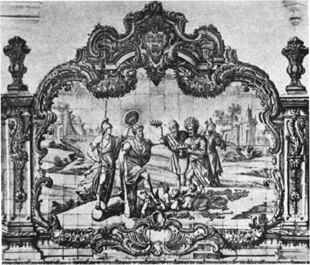
Fig. 2 Tile panel with the motto Quis dives? Qui nihil cupit.
| |
Vaenius' Quinti Horati Flacci EmblemataFor his book Vaenius selected fragments from Horace's poetry such as the Carmina and the Epodes. He also used Horace's letters, especially the famous ‘Ad Pisones’, which is better known under the title of Ars Poetica and as such formed a central text in the tradition of writing about the visual arts. Vaenius completed his collection with sententiae by Seneca, Ovid, and Cicero, as well as contemporary authors who were essential to the shaping of his ideology, such as Lipsius. These thematically selected quotations he complemented with images of his own design, possibly engraved by his brother Gijsbert.Ga naar voetnoot12 The Quinti Horati Flacci Emblemata became a bestseller in its genre; the text saw at least twenty new editions in different languages in the seventeenth and eighteenth centuries, often with new engravings after the originals, which consequently display them in mirror image.Ga naar voetnoot13 The images on the tiles in the Franciscan cloister correspond to the | |
[pagina 132]
| |
images in the first edition; one of the later editions is now in the possession of the library of the monastery.Ga naar voetnoot14 The year the book was first published saw two new and textually variant editions with explanations in Dutch, and in 1683 two other versions with Dutch texts were published in Brussels and Amsterdam, the latter of which contains an elaborate introduction. The introductions to the Emblemata in Latin and Dutch instruct the reader how to read Vaenius' book and therefore they are essential in our understanding of the contemporary visitor's ‘reading’ of the decorations in the Franciscan cloister. Indeed, the introductions to these emblem books constitute a rare instance of theoretical prescription to the use of this kind of mural decoration. The Latin introduction is directed at ‘the reader or the spectator’ (Lectori seu spectatori). The anonymous author of the Dutch introduction compares the manner in which Vaenius' imagery conveys its messages to the workings of hieroglyphs: a visual language to be ‘read’ just like the text.Ga naar voetnoot15 The early modern belief that the visual and the verbal do not constitute two essentially separated domains is a notion that has its roots in antiquity, and that is stressed by Horace himself. The idea is based on the Aristotelic assumption that thinking has a visual foundation: as De anima clearly states, ‘the mind never thinks without images’.Ga naar voetnoot16 The Latin introduction to the Emblemata therefore stresses Horace's formula ut pictura poësis as well as his famous conviction that ‘the mind is stirred less vividly by what finds entrance through the ears than by what is brought before the trusty eyes, and what the spectator can see for himself’.Ga naar voetnoot17 Vaenius' project is not so much a reconstruction of Horace's ideas as an expression of his own ethical convictions, communicated through the words of canonical authors from antiquity as well as of modern writers. Vaenius' ethics is best described as the Christianised adaptation of ancient atomism that has in modern scholarship been given the name of neostoicism. It propagates not the search for truth but for wisdom, which, as the introduction to the Emblemata states, is the only ‘guide to a life in constancy’.Ga naar voetnoot18 It professes the doctrine that ‘there is no wealth, as to desire no wealth; there | |
[pagina 133]
| |
is no poverty when someone is satisfied with his fate; and no other freedom, than wisdom’.Ga naar voetnoot19 In the Latin text the author refers emphatically to Justus Lipsius' Manuductio ad stoicam philosophiam, and explicitly states that in the Emblemata ‘not only ethics, but also the dogmas of moral and stoic philosophy, are expressed by means of images’.Ga naar voetnoot20 | |
The dialectics of the cloister's imageryVaenius' folio-sized engravings (some editions of his book are even in quarto) are in the cloister in Salvador expanded into sizeable mural decoration. From essentially philosophic mnemotechnical devices, the engravings are transformed into large murals with a function rooted in religious practice. The selection of the images as well as their arrangement on the four walls of the cloister allowed the artists who created the decoration to adapt the stoic philosophy of Vaenius' imagery to the needs of Franciscan doctrine. In what follows, I will attempt to reconstruct the ‘dialectics’ of this decoration project: the manner in which the topoi offered by Vaenius' book were ordered anew in the conceptual framework of Franciscan theological interests, a process in which ancient and familiar images recurred in a new visual structure for the sake of a specific argument. This manner of appropriation by means of organisation, by using an old and authoritative vocabulary and applying it in a new argumentative structure, is in accordance with the art of dialectics as it was defined from Rudolph Agricola's De inventione dialectica (1479) onwards.Ga naar voetnoot21 How were Vaenius' images and the ideology they confer adapted to the Franciscans' needs, what was gained or lost in the process? For the panels roughly one third of the emblems were selected (37 of 103 images).This selection process provides an important indication of the manner in which Vaenius' ideas were adapted to the monastery's context. Another indication is provided by the order in which the images are arranged. It is immediately apparent that in the organization of the themes on the cloister's walls, the artists did not adhere to the order established by Vaenius. Where Vaenius' narrative opens with the image of a sole personification of Virtue and leads one irrevocably towards the image of Death on its final page, the order of the images on the walls is not linear in this sense; none of the panels functions as a ‘starting point’ for a one-way | |
[pagina 134]
| |
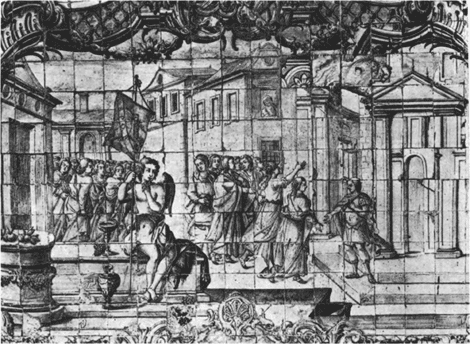
Fig. 3 Nihil silentio utilius.
interpretative tour around the cloister. Indeed, the focus of attention is not to be found at the beginning or end of each wall, but is formed by the panels located in the centre of the walls. Instead of forming a linear composition, the imagery of the panels appears to be arranged according to the function of the architecture that lies behind each particular wall. The four walls of the cloister are adjacent to parts of the religious complex that all have quite different functions: the church, the chapter-house, the friars' cemetery, and the monastery itself.Ga naar voetnoot22 On the wall adjacent to the church, the central panel features the motto of the gold- | |
[pagina 135]
| |
en mean: in medio consistit virtus. This wall emphasizes virtues such as silence (nihil silentio utilius) (fig. 3), the evasion of vices (vitium jugere virtus est), the importance of philosophy (philosophia vitae magistra) and the positive aspects of old age (varia senectae bona). The wall adjacent to the cemetery on its central panel carries the motto mors ultima linea rerum (compare fig. 4) and is entirely devoted to transience, presenting statements like volat irrevocabile tempus, tempora mutantur, the only philosophy is the meditation on death, but also informing the viewer that if one leads a life determined by reason one need not fear death (tute, si recte vixeris). The wall adjacent to the monastery represents the theme of decorous social behaviour. According to the neostoicism adhered to by Vaenius all ‘rules of conduct’ are to be found in nature, and they therefore essentially overlap with the laws of nature. One should behave ‘according to nature’ (vivere secundum naturam) and live up to the fatum stoicum, that means reckoning with a certain degree of determinism in human conduct. As a consequence, this wall emphasizes the mutual necessity of art and nature (naturam minerva perficit). Moreover, it features another instance of the golden mean (medio tutissimus ibis), the observation that in nature every power is submitted to a greater power; the power of a people living in concord (which, in this case, equals the concord of the fraternity), and an admonishment to be content with one's fate (sors sua quemque beat). The wall adjacent to the chapter-house is devoted entirely to the subject of money. It proclaims that he who covets nothing is a happy man (quis dives? qui nihil cupit) and it ridicules those who serve Mammon (pecunia donat omnia; pecuniae obediunt omnia; varium pecuniae dominium). Apart from these negative morals, it also stresses the virtue of labour itself (fructus laboris gloria). Remarkably, the titles of the tile panels inserted in ornamental frames do not always correspond to the titles of the emblems in Vaenius' book. In effect, they occasionally derive from Horace's original writings. Where Vaenius calls an image virtuti sapientia comes, for example, the corresponding panel in the cloister reads vitium fugere virtus est: the first words of Horace's maxim as cited by Vaenius.Ga naar voetnoot23 This discrepancy probably derives from the artists' wish to remain faithful to the antique source that they considered a greater authority. A correct order in which to read the ‘hieroglyphical’ imagery on the walls does not exist. The inhabitants of the monastery would cross the walkways of the cloister in various directions several times a day. Going from the monastery to the church they would pass the wall adjacent to the cemetery, and be reminded of their deceased predecessors and the fact that true philosophy is the meditation of death. When going from the monastery to the chapter-house that opened onto the outside world, they would be confronted with the role of money in worldly affairs. Approaching the church from the chapter-house, they would be reminded of virtus in a general sense. Before entering the monastery, they would face the social decorum that also pervaded their small religious fraternity. | |
[pagina 136]
| |
In contrast to the one-way narrative that determines the organisation of Vaenius' book, the order of images in the cloister is in accordance to a ‘peripatetic’ narrative consecutive of the friars' daily and varying routes through the galleries. One is tempted to associate the tile decoration with the original meaning of the ‘stoa’, the proverbial antique column gallery built to facilitate philosophical discussion. The etymology of the word stoicism may have been one of the factors to inspire the designers of the monastery in decorating the cloister with the philosophical imagery developed by Vaenius. We can conclude, therefore, that the organisation of the images in the cloister appears to have been adapted to the diverse functions of the various monasterial spaces. As such, the decoration served as the virtual ‘stage-setting’ for the friars' everyday routine. The performative aspects of the decorative panels in this particular role as scenery will be considered in the final sections of this article. With respect to the selection of emblems from Vaenius' originals, one can quite readily conclude that the fraternity saw best not to include his exhortations concerning the beneficial consumption of wine (in the Emblemata, images 29 and 80), the importance of poetry (image 76) and other recreational activities (images 30 and 77), as well as his emblems on the negative effects of poverty (image 64). The Franciscans were more attracted to the stoic doctrine of determinism and private constancy in moments of public consternation than to stoicism's artistic component and its guidelines for behaviour in the context of the vita activa. In their selection of images the Franciscans evidently concentrated on the stoic notion of vanitas, as it is famously epitomized in the inscription on Lipsius' grave: hvmana cvncta fvmvs vmbra, vanitas, et scaenae imago, et verbo vt absolvam, nihil.Ga naar voetnoot24 The most important iconographical addition to the decoration project occurs on the panel mors ultima linea rerum (fig. 4).As discussed above, the corresponding image figures on the final page of Vaenius' book. In the cloister it has been given a similarly key position: it is located in the centre of the only wall that is not interrupted by a door or entrance: the wall adjacent to the cemetery. It is also the only panel to carry an inscription on the lower part of the frame. It reads Coemeterium fratrum and marks the images on this wall as the symbolic realm that corresponds to the space of the monks' cemetery behind it. An addition has been made to the image itself: where in the engraving is depicted a book with open pages filled with illegible scribbles, on the panel these pages are inscribed with a poem in Portuguese, stressing man's frailty and the imminence of death.Ga naar voetnoot25 Fragoso rightly draws attention to the cloister's secluded position: whereas the church was a place where the spheres of public and private religiosity met, the cloister had a private function. This private function enabled the iconography of the cloister's decorations | |
[pagina 137]
| |
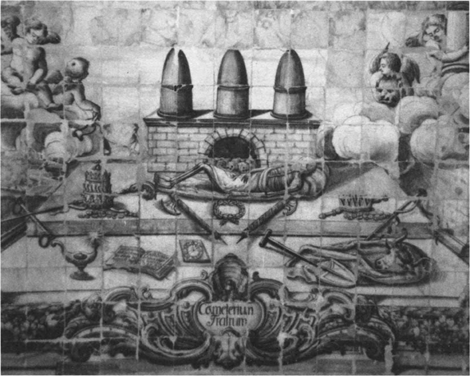
Fig. 4 Mors ultima linea rerum.
to be acute and severe.Ga naar voetnoot26 The message delivered by the tiles generally emphasizes virtue, following the stoic doctrine that it is not truth that the virtuous man should try to discover, but wisdom, since wisdom is as the strife for virtuous behaviour the only ‘freedom’.Ga naar voetnoot27 The end of the path to wisdom will not be reached in this life, which is under the spell of death. Only daily contemplation will turn a man into a vir proficiens who will remain on his way toward the goal of becoming a vir sapiens. In this context the images on the second floor of the cloister also fit into its general iconography. As has been noted by Sinzig, the landscapes and sea scenes on the tile panels on this floor can be interpreted in a general sense as praise to creation itself, as a revelation of the Creator's powers and of the ‘laws of nature’ that are also the laws of human conduct.Ga naar voetnoot28 This doctrine regarding nature as ‘second Bible’ is one of the central themes of neostoicism.Ga naar voetnoot29 | |
[pagina 138]
| |
From engravings to tile panelsHow were Vaenius' individual illustrations adapted to the needs of the Franciscans? The transposition of the engravings to tile panels had some obvious transformative effects. First of all, the upright images from the book are changed to broad oblong formats, surrounded by elaborate frames suggesting richly ornamented architecture, containing flowers, vases and masks.Ga naar voetnoot30 The designers of the tiles quite simply fitted Vaenius' figures into this oblong format, most of the times simply by leaving more space in between and around the figures. In some cases, however, changes and additions to the book illustrations were made. An example of these changes can be found in the differences between the illustrations to the motto incipiendum aliquando in the book and on the cloister walls (figs. 5 and 6). Comparison of the engraving with the tile panel reveals the consequences of the transformation from the folio-sized illustration to the oblong panel format. Without effectually adding or removing figures or objects of major significance to Vaenius' original composition, the image on the panel gains greater depth through the stretching of the horizon and the profusion of details in the landscape. These details both accentuate the horizon and allow the virtual space between the beholder and the horizon ‘recognizable’ as a vast stretch of land, to use a term from seventeenth-century art theory.Ga naar voetnoot31 Also the figure of a man building a wall to the left of the image, a figure that in Vaenius' engraving is partly cut from sight by the image's border, is fully restored in the tile panel, an alteration that adds to the sense that the depicted scene takes place in a large landscape. A similar procedure was applied, for example, to the image to volat irrevocabile tempus: the four figures were simply put further apart (figs. 7 and 8). A comparison of the images accompanying the motto pecunia donat omnia (figs. 9 and 10) also yields some interesting observations. Here Vaenius' original setting in a domed archway is on the tile panel replaced by a scene in the open air. The attending multitude at first sight seems to have been considerably enlarged; an effect established by the addition of no more than a single new face, positioned next to the bearded man on the second row. The most essential visual characteristic to result from this transformation from engravings to tile panels is that the book illustrations in their new oblong formats constitute a kind of stage setting. The richly ornamented frames that suggest semi-columns and see-through archways decorated with garlands of real flowers in particular add greatly to the illusion that the panels yield onto a landscape which is a continuation of the space in front of the image. The elaborate background landscapes similarly add to the sense of depth in this virtual reality and strengthen the suggestion that the viewer's gaze penetrates the wall to wander off into the distance. Apparently in order to | |
[pagina 139]
| |
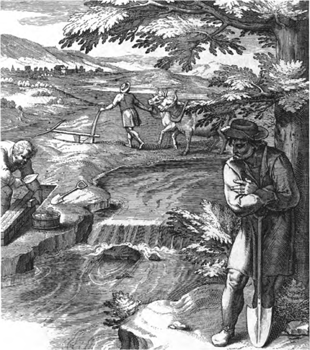
Fig. 5 Incipiendum aliquando, engraving from O. Vaenius, Quinti Horati Flacci Emblemata, Antwerpen 1607, p. 35.
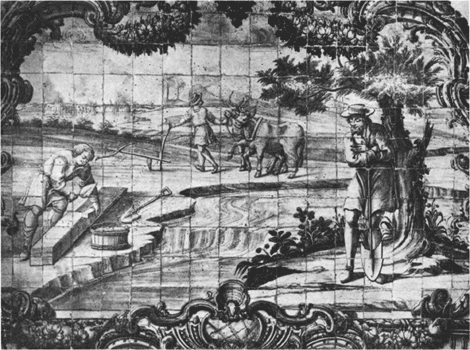
Fig. 6 Incipiendum aliquando.
| |
[pagina 140]
| |
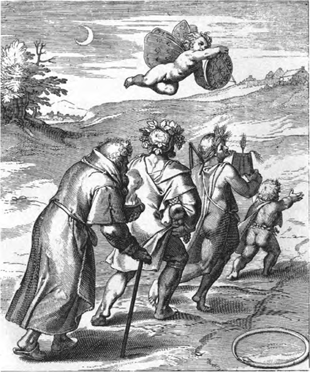
Fig. 7 Volat irrevocabile tempus, from Vaenius, Emblemata, p. 207.

Fig. 8 Volat irrevocabile tempus.
| |
[pagina 141]
| |
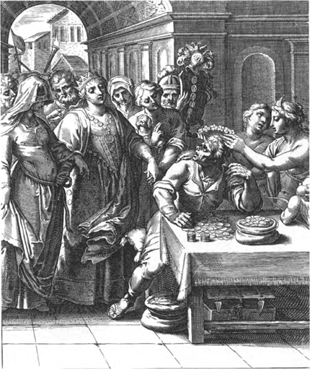
Fig. 9 Pecunia donat omnia, from Vaenius, Emblemata, p. 129.
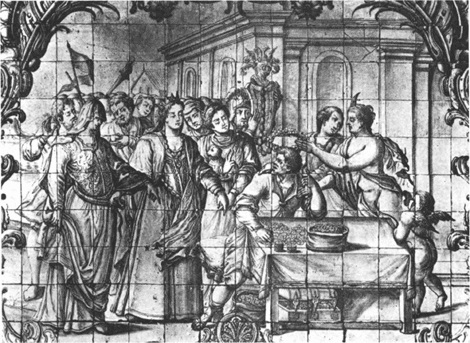
Fig. 10 Pecunia donat omnia.
| |
[pagina 142]
| |
strengthen this suggestion, most scenes that in the book have an interior setting are on the cloister walls transposed into a landscape. The suggestion of a virtual reality is further enforced by the subtle integration of the panels into the surrounding architecture. The width of each tile panel is identical to the span of each arch of the cloister's arcade, and the stone columns are placed parallel to the painted columns in the decoration. This architectural arrangement results in the suggestion that the panels, in the same way that the actual arcades open onto the centre court, through their frames give a view of landscapes in which allegorical figures perform their parts (compare fig. 1). As will be discussed below, this sense of sharing the same space and even the same reality with allegorical figures appealed greatly to the expectations of the early eighteenth-century Brazilian public in the context of religious and artistic experience. Moreover, the masks integrated into the frames surrounding the images may similarly refer to the panels' stage-like appeal. Whereas Sinzig has called the decorative tiles a non-stop ‘sermon in azulejos’ accompanying everyday routine,Ga naar voetnoot32 Fragoso has more recently and aptly deemed them a ‘theatre in azulejos’, referring to the title of Vaenius' work in Spanish, entitled Theatro moral. This translation's anonymous editor states elsewhere that ‘man's life is a stage, where everyone plays his part; the playwright is God, [...] people are the actors, and Death is he who strips everyone of his clothes’.Ga naar voetnoot33 The Dutch introduction to the Emblemata likewise states that one image depicts how Death puts up a ‘stage for her lottery, to be seen in public’.Ga naar voetnoot34 The titles that Vaeniu's work later received all refer to the ‘theatrical’ qualities of the images: in French, La spectacle de la vie humaine, in Dutch Schouwtoneel des menschelyken leevens, while a German edition is entitled Theatrum morale. What has gone unnoticed in the historiography of Vaenius' book, however, is that only in the monastery in Salvador, Vaeniu's imagery is transfermed into an art form that can truly be called performative, as will be explained below. | |
‘Painting with affects’ (schildery der Hartstochten)The ‘dialectics’ of the decoration project, the rationale behind the selection and organization of Horatian commonplaces, reveals a special interest in vanity and virtue. The imagery is obviously aimed at meditation, rehearsing the idea that those who frequented the cloister needed to live ‘according to nature’, to follow the golden mean, and ought not to give in to their passions or to earthly distractions. However, apart from meditation the application of the images to their religious setting knew another important aspect. | |
[pagina 143]
| |
The Franciscan cloister is a rare example of how seventeenth-century emblems could be converted into a ‘performative’ architectonical project. The finely engraved illustrations, intended to be examined from close by, were transferred into oblong frames, comparable to window panes with a view on the outside world. Moreover, the azulejos had to function without an accompanying text. Apart from the sometimes quite enigmatic titles of the panels, the artists needed to rely entirely on the force of the visual to convey their message. In the introduction to the Emblemata the function of the images is described as ‘painting with affects’ (in Dutch, schildery der Hartstochten). The terminology of the ‘affects’, as the element of Lipsius' neostoicism which most interested artists in Vaenius' circle, functions in the seventeenth century to describe the effectiveness of the dramatic arts: by stirring the spectator's passions and his imagination, theatre and visual art could eventually cause a lasting change in character.Ga naar voetnoot35 Vaenius' illustrations are in the cloister transformed into a stage-like setting where art, philosophy, and architectural location are functionally interrelated in order to affectively address the Franciscans and enhance consciousness of their ‘role’, their behaviour with regard to each other, and to the outside world, God, as well as the hereafter. More literally than most readers of Vaenius' book, the monks who frequented the cloister ‘enacted’ in their lives and in their religious practices the moral philosophy expressed by the images. Their relative seclusion from the secular world as well as their vows of poverty directly put the moral lessons into practice that were initially in the form of book illustrations intended as admonishments. The Franciscans must have taken to heart the introduction to Vaenius' book, which states that his images are ‘meaningful figures, to urge those who love good morality to let their thoughts dwell longer on these pleasing and instructive matters, and to guide them, as if taken by the hand, towards praiseworthy things’.Ga naar voetnoot36 The performative aspects of Brazilian baroque visual art are stressed by Luiz d'Araujo who describes it in terms of a performance intensely unifying art and religious practice. He describes how art and culture in general revolved around festivities that were rich in allegorical role-play and decoration. Pagan mythology and allegory were ubiquitous in these festivities, subordinated to the grander scheme of the ‘triumph of the true faith’. Popular personifications to appear in pageants, dressed in elaborate symbolic garb were the seasons and planets, virtues and vices, or figures of classical mythology. Luiz d'Araujo stresses the relevance of the text O Triunfo Eucarístico by Simão de Ferreira Machado, published in Lisbon in 1734 and giving an eyewitness account of how visual metaphor functioned in religious festivities. The multilayered imagery was connected | |
[pagina 144]
| |
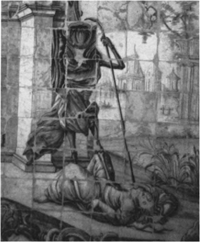
Fig. 11 Post mortem cessat invidia (detail).
to the different fraternities and orders.Ga naar voetnoot37 The Franciscans' choice of images of transience and contempt for worldly goods as it has been expressed in the decoration in the cloister in Salvador might have functioned as ‘trademark’ of their order. In Brazilian festive culture, images like the winged and bearded Saturn, depictions of Virtue with a Greek helmet, figures of Fame with trumpets, angels with banners like Harpocrates, crowned kings, or the snake-haired figure of Envy, figures that also appear on the azulejos in the São Francisco monastery, appealed very directly to the visual memory and expectations of Brazilian religiosity Visual culture in Brazil centred almost exclusively on the evocation of this virtual reality in which pagan and Christian imagery became fused in a catholic syncretism, and in which the personification of Death with skull and scythe or the pagan gods were no strangers, but in effect very common characters to encounter. That the azulejos in the monastery of São Francisco were regarded as highly performative in this sense appears from the vandalism suffered by the figure of Death in recent years, to the extent that some of the tiles in several places had to be removed. These damaged tiles were subsequently replaced cosmetically with tiles that remind of the missing parts only in terms of general design, but that do not resemble the original image at all, a procedure that resulted in curious solutions (fig. 11). The panels' power to evoke a virtual reality and to ‘paint with passions’ had apparently reached a point of perfection.Ga naar voetnoot38 | |
[pagina 145]
| |
ConclusionThe anonymous artists creating the tiles for the Franciscan cloister were able to reinterpret and adapt Vaenius' imagery and its moral ethics to the needs of an eighteenth-century colonial monastery - a feat above all significant in terms of the persuasive force of Vaenius' imaginative emblems, something the modern visitor of the monastery is bound to acknowledge. The appropriation of Vaenius' syncretistic stoicism by the Franciscans' ideology is remarkable. The illustrations are transformed to a stage-setting that forms the backdrop to the friars' everyday practice of the doctrine of contempt for the profane, and the images therefore performatively stress the stoic conviction that life is no more than, in Lipsius' words, ‘a shadow, a stage, and in effect, nothingness’. It is striking that Vaenius' images lent themselves so effectively and without apparent effort to the process of transfer from graphic to mural art. The tiles of the monastery of São Francisco remain without doubt the most compelling evidence of the acclaim and lure of the visual culture of the Netherlands in Brazil, notwithstanding the political struggle with the ‘Flamengos’ in the recent past. Abstract - The tile decorations in the cloister of the monastery of São Francisco in Salvador, based on the engravings to Otto Vaenius' Quinti Horati Flacci Emblemata (1607), have largely escaped the attention of scholars focusing on the reception of Dutch visual culture in colonial Brazil. An analysis of the way in which the book illustrations were transformed into large-scale architectonic decoration leads to the twofold conclusion that in terms of iconography the Franciscans adapted Vaenius' neostoicism to their own ideological needs, and that in terms of design the images obtained a performative function in the context of Brazilian religious experience. |
|

